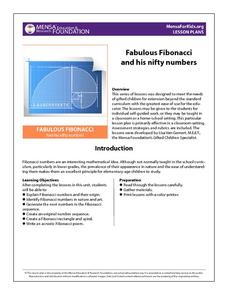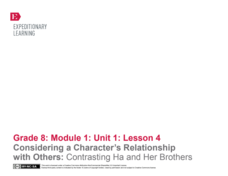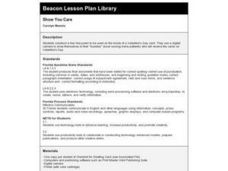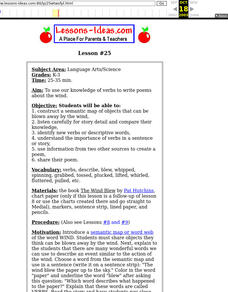EngageNY
Poetic Tools in Narrative of the Life of Frederick Douglass
Scholars listen to a reading and answer probing questions about If We Must Die by Claude McKay. Readers annotate their personal copies of the poem as they discuss its figurative language, vocabulary, and meaning. They then transfer their...
K20 LEARN
From Apples To Oranges: Examining Literary Devices
Make learning the definitions of literary terms memorable with a fun and engaging activity. Teams of scholars are given several terms and create an acrostic poem with simplified definitions and examples.
Curated OER
Kindergarten-sight Words Fall Colors
Students listen to the poem Fall Colors and find their favorite Fall color. In this Fall color lesson, students recognize the Fall color words. Students make leaf prints with their favorite colors. Students talk about their leaf prints.
K20 LEARN
Manifest Destiny: U.S. Territorial Expansion
A close examination of John Gast's painting "American Progress" launches a study of the concept of Manifest Destiny used to justify United States' policy of westward expansion. Young historians read statements from persons with different...
Curated OER
Symbols and Trading Cards
A silk rank badge was a symbolic emblem worn by high officials during the Qing Dynasty. Your class will get a chance to examine the details, symbolism, color, and design of such a badge as they make their own symbolic trading cards....
Learning for Justice
Maya Angelou
Maya Angelou's poem, "Still I Rise", offers young scholars an opportunity to consider how poets use literary devices to create powerful messages. After a close reading and discussion of the poem, class members reflect on how they can...
Curated OER
I Spy Poetry
Explore the components of rhythm and form through a reading of Jean Marzollo's I Spy books. After discussing Marzollo’s format, the class agrees upon a theme for a class book and topics that fit with that theme. Pupils write a poem,...
Curated OER
Pictures in Words: Poems of Tennyson and Noyes
Students examine how Tennyson and Noyes use words to paint vivid pictures. They read and analyze two poems, complete an online scavenger hunt, complete a worksheet, and write examples of alliteration, personification, metaphor, simile,...
Curated OER
Picture Perfect Poetry
Do your language arts students love to draw? Use this lesson to reinforce poetic techniques with illustration. After drawing what they think poem would look like with no words, middle and high schoolers work on several different...
K20 LEARN
Identity: Characterization/Character Traits
"Who am I?" Guy de Maupassant's short story "The Necklace," Julio Naboa Polanco's poem "Identity," and a clip from a Jason Bourne film provide learners with a context to consider the traits that makeup identity. Scholars create a...
Curated OER
I Spy Poetry
Young scholars identify and interpret the rhythm and form of the I Spy poem.
They then integrate art, music, literature, technology, and writing with poetry. Students also write their own poem based on the picture they printed from the I...
National Endowment for the Humanities
Lu Shih — The Couplets of T’ang
Writing poetry in ancient China was the modern equivalent of sending a greeting card. Scholars learn about the ancient Chinese poetic form called the lu shih. They read about the context of poetry during the T'ang Dynasty and complete a...
MENSA Education & Research Foundation
Fabulous Fibonacci and His Nifty Numbers
Fibonacci numbers are not only found in the classroom but also in nature. Explore the concept of Fibonacci numbers through a series of lessons designed to gain insight into the mathematical reasoning behind the number pattern, and spark...
Curated OER
Tricks of the Trade A Collection of Concrete Poems-for writing concrete poems
Students explore concrete poetry. In this instructional activity about poetry, students read A Poke in the I, by Paul B. Janeczko, and are introduced to concrete poems. Students read several different kinds of concrete poems including...
Curated OER
Do You Want to Be My Friend?
Learners participate in a variety of emergent and early-literacy activities based on a "friendship" theme. Learners listen to the book Do You Want to Be My Friend by Eric Carle, then echo read, choral read, and independently read...
Curated OER
Twirly Whirly Milk
Student observe the effect soap (or detergent) has on the movement of food color in milk. Pupils observe the properties of solids and liquids while making butter. They read a poem, Shaking, and listen for ryhming words. Studdents...
Curated OER
Similes & Metaphors
Similes and metaphors are the focus of a 57-slide presentation that your class members should find engaging. Although your students may find the musical selections dated, the color coding highlights the similes and metaphors found in...
K20 LEARN
It’s Never Too Late to Apologize: Character Development and Theme in “The Scarlet Ibis”
Sometimes saying I'm sorry just doesn't cut it. Scholars examine a series of apology poems, songs, and stories and consider each speaker's regrets. Using what they have learned, they analyze James Hurst's short story, "The Scarlet Ibis,"...
EngageNY
Considering a Character’s Relationship with Others: Contrasting Ha and Her Brothers
Who is Ha? Scholars look closely at the poem Papaya Tree and carefully examine the character Ha. Learners work in groups to create an anchor chart defining Ha's character. They also answer text-dependent questions to help with...
Curated OER
Let's Fly Our Kites
Students practice reading and writing using a short poem and information about kites. In this kite poem lesson plan, students read and write using a common poem. This lesson plan includes practice with reading, rhyming, handwriting,...
Curated OER
Show You Care
Young scholars construct a four-line poem to be used on the inside of a Valentine's Day card. They use a digital camera to show themselves to their "buddies" (local nursing home patients) who receive the cards on Valentine's Day.
Curated OER
Oceans-A Fact Haiku
Students create haiku poems. In this poetry lesson plan, students listen to the sound of the ocean from an audio file and write a haiku poem about oceans.
Curated OER
Hands Poem
Students create a "Hands" poem for the author/character in a reading selection.They make inferences for reading selection and back up inference by citing specific lines in text. They relate author's or main character's experiences to...
Other popular searches
- Color Poems Using Similies
- Color Poems Using Similes
- Simple Color Poems
- Color Poems Using Metaphors
- Writing Color Poems
- Green Color Poems
- Color Poems With Pictures
- Acrostic Color Poems
- Color Poems Red
- Color Poems Unit
- 1st Grade Color Poems
- Blue Color Poems

























